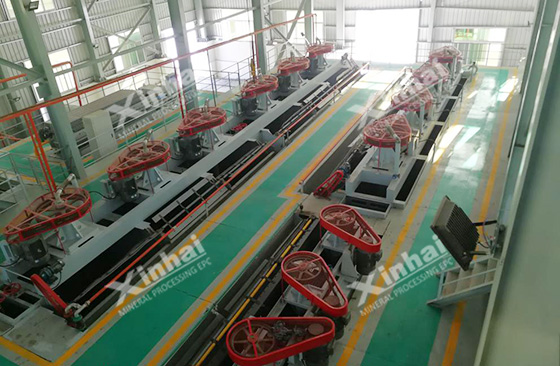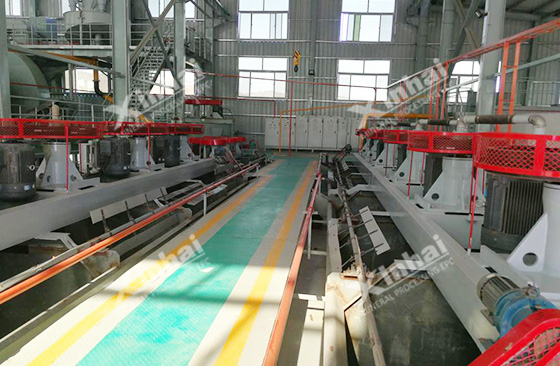

Warm Tip: If you want to know more details about equipment, solutions, etc, please click the button below for free consultation, or leave your requirements!
Froth flotation process can be divided into one stage froth flotation and two stages froth flotation (also known as stage froth flotation). So how do you choose the froth flotation process according to the stage? Generally, the selection of froth flotation stages mainly depends on the embedding features of useful minerals.

One stage froth flotation is to adopt froth flotation process after grinding (the ore is ground to the upper limit of the particle size that can be floated), and any flotation products do not need to be further grinding, it is called one stage froth flotation process, or one stage grinding – froth flotation process.
1) The useful mineral has the uniform disseminated grain size, the mineral has relatively coarse grain size and not easy to sliming. For example, when the heavy metal sulfide ore is 0.3mm, the useful minerals can be separated by monomer basically. The qualified concentrate and waste tailings can be obtained by one stage grinding - froth flotation process after rough grinding.
2) The useful minerals has the fine disseminated grain size but not uniform and not easy to mud. For this kind of mineral, we can use two consecutive grinding, and then froth flotation. There is no need regrinding in this one stage froth flotation. For example, the grain size of some crystalline minerals needs to be ground below -0.074mm to basically achieve monomer separation of useful minerals. The grain size of such minerals must be fine and uniform, which meets the requirements of one stage froth flotation.

Stage froth flotation process is mainly because the ore has uneven disseminated grain size, which is necessary to be carried out grinding operation after a stage froth flotation process, that is known as the two-stage froth flotation process. By that analogy, this is multiple stage froth flotation.
The main purpose of stage froth flotation process is to avoid the overgrinding or argillation between useful minerals and gangue minerals in ore, and to make the gangue minerals discharged as tailings as far as possible at a coarse-grained size. Sometimes, the stage froth flotation process is to separated a part of liberated coarse concentrate firstly.
This process is mainly used to deal with the ore with more complex grain size of useful minerals, or the ore with mud in the grinding process. The stage froth flotation is divided into three forms: concentrate regrinding, middling regrinding and tailings regrinding process.
Concentrate regrinding means that the ore contains two or more kinds of useful mineral, they are connected to each other, and each useful mineral has a finer grain size, but their aggregate is thicker, in this case, concentrate regrinding can be used.
One stage grinding uses coarse grinding to dissociate the aggregate of useful minerals from gangue ore, and then carries on the froth flotation, then the mixed concentrate and tailings are obtained, the concentrate is carried on the secondary grinding to further realize the monomer dissociation of the aggregate mineral, and then carries on the froth flotation to obtain each kind of useful mineral concentrate.
Middling regrinding can be used when the dissemination grain size of useful minerals in the ore is not uniform and the distribution of useful minerals in the ore is not uniform.
The first stage grinding dissociates coarse and useful minerals, and the gangue minerals produced directly enter the tailings waste. Part of the fine and useful minerals produced are the minerals associated with gangue body, and froth flotation is carried out to obtain part of the coarse concentrate and waste part of the tailings. Among them, there are some syngene minerals, which need to be regrinding to realize the monomer dissociation, and then enter the froth flotation stage again to separate the useful fine-grained minerals.
The dissemination grain size of useful minerals in the ore is not uniform, but the distribution of useful minerals in the ore is uniform.
One stage grinding makes the coarse grains basically dissemination. After froth flotation, a part of the concentrate is separated, and then the tailings containing fine useful minerals will be regrinding, re-floatation, and the fine useful minerals are separated. This process can also be used for ore that is easy to oxidize or slime.
The above are several common froth flotation processes of flotation machines. They are important processes, which have a great impact on the mineral separation index. Therefore, selecting the reasonable froth flotation process is the main factor to ensure the best separation index and the lowest production cost.
Last: Different Gold Ore Processing Methods for 5 Kinds of Gold Ore
1Slurry Treatment and Flotation Reagent Selection of Non-sulphide Mineral Flotation
 0
0
 4345
4345
2How To Do Flotation Test?
 0
0
 5048
5048


What Are the Differences Between CIP and CIL?
 11312
11312
 0
0